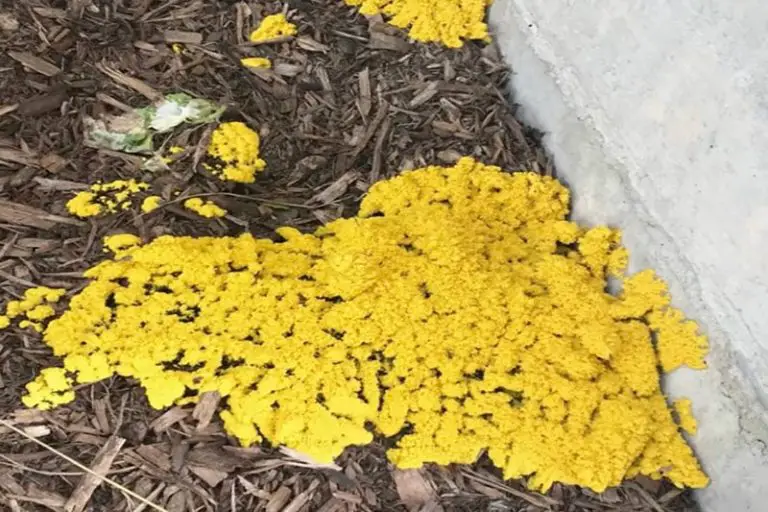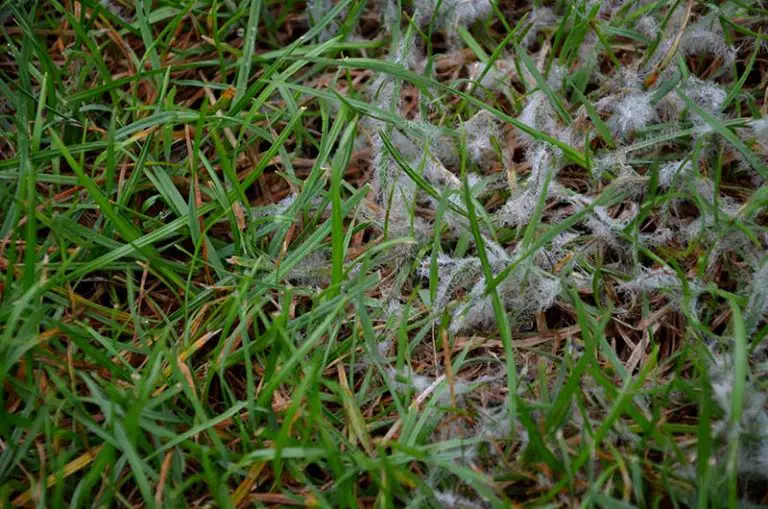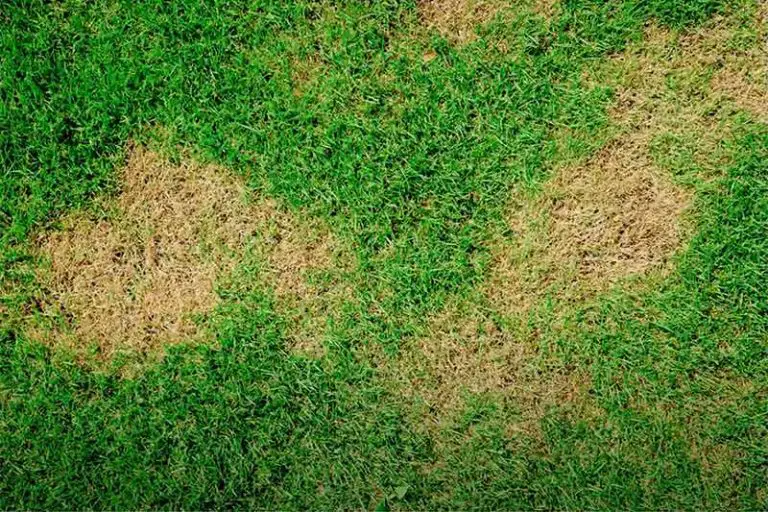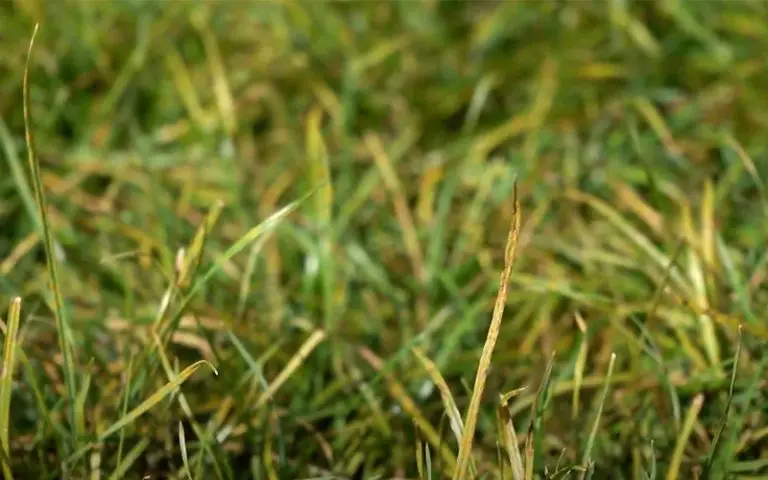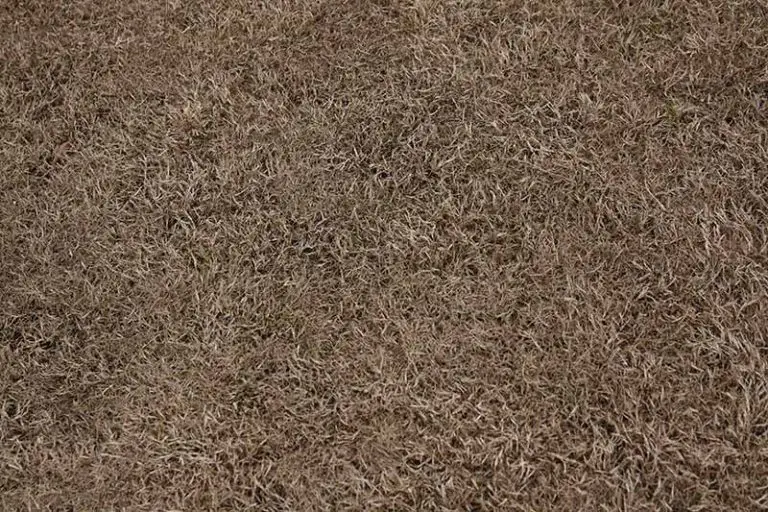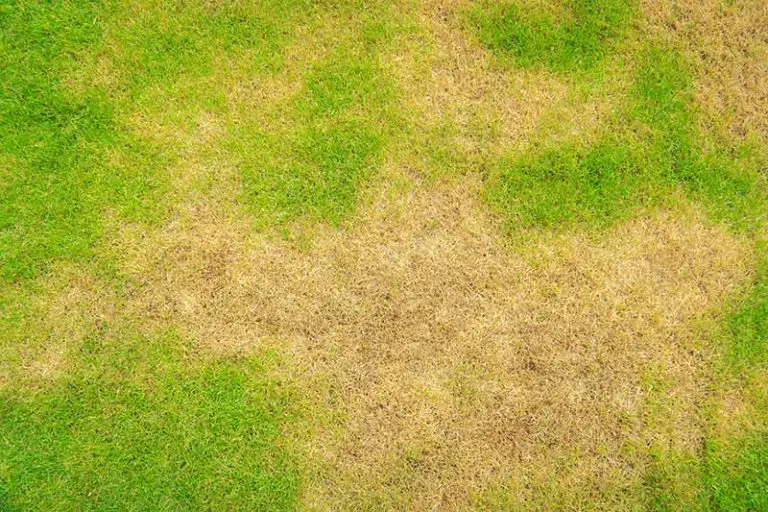How To Identify And Get Rid Of Dollar Spot Fungus
The word “fungus” conjures up visions of dirt, decay, disease, and rot, at least in my mind. Even though the term Dollar Spot Fungus sounds nicer, it is still a disease that can and will affect your lawn if the conditions are right.
Dollar Spot Fungus presents as a tan or straw-colored round spot on managed and manicured lawns. The spot can range from 1 to 6 inches (2.5 to 15 cm) in diameter. The most effective way to eliminate this disease is by applying a commercial fungicide product intended for lawn treatment.
Dollar spot fungus, also known as Dollar spot lawn or turf disease, is a disease that attacks managed turf areas like golf courses. This type of fungus thrives on closely mown turf and favors warm days and cool nights followed by dew. Too much irrigation could cause this unsightly disease to run rampant throughout your carefully manicured lawn area. Still, there are ways that you can prevent Dollar spot fungus and heal the diseased area.
How to Identify Dollar Spot Fungus (Sclerotinia Homeocarpa)
Dollar spot fungus is relatively easy to identify on your lawn. It appears as a tan or straw-colored sunken, round spot, resembling a silver dollar. While the name may not seem very creative, it does describe the fungi perfectly!
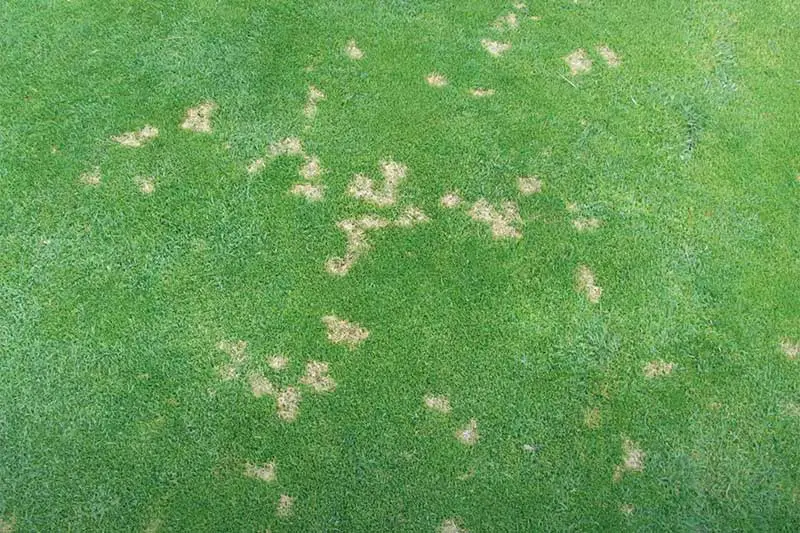
The second way to identify this fungus is by the infection marks on each blade of grass. Dollar spot can attack the center of individual leaf blades of the grass without attacking the blade’s crown or root. Infected leaf blades remain upright, but the infection is easily noticeable as each blade will have a light tan band with light reddish-brown margins around it.
As the band expands and tightens around the blade in an hourglass shape, the blade’s top half is strangled and dies. After the top of each leaf blade dies, it turns white or tan, causing the distinguishable dollar spot. Each blade could have multiple bands if the infection is bad enough.
If you are still unsure if your lawn has been affected by this aggressive fungal disease, check the suspected infected blades of grass for signs of infection. The fungus can appear as small, fuzzy, cottony strings, called mycelium (or fungal growth), growing across the diseased leaf blades.
Sightings of mycelium will often happen when heavy dew is over the lawn if the area is infected, but it will disappear as the blades dry during the day.
The Dollar Spot Fungus is not picky and will infect any grass type if the conditions are right. Home lawns and athletic fields are not exempt from this fungus. It will infect any manicured lawn and turf area if provided with the right growing conditions.
How Does Dollar Spot Fungus Affect Golfing Greens?
Even though all types of cool and warm-season turfgrass are susceptible to the Dollar Spot Fungus, turf on golf greens, tees, and fairways are the ideal surface turf for this disease and are most often attacked.
On putting greens in particular, because of the kind of grass used, mostly Creeping bentgrass and Annual bluegrass, the Dollar Spot infection could be between 1 to 6 inches (2.5 to 15 cm) or even more in diameter!
The reason for this is to do with the length of the grass. If the grass is mowed to a height of 0.125 inches (31 cm) as on a golf putting green, the disease presents as a small silver dollar spot. If the grass is coarser and is cut at a height greater than 0.5 inches (1.27 cm), the disease can spread quickly over the turf and present in larger patches.
Be sure of the type of grass you have planted, as the hourglass bands might not appear on certain warm-season grasses, so you would need to identify the fungus using the other means listed.
Unless you have a very severe outbreak of Dollar Spot disease on golf greens, play should not be interrupted on more extended cut areas, but the spots could cause uneven ground affecting how the ball will roll. Aesthetically, silver spots on a well-manicured lawn do not look too nice, either!
Is Dollar Spot Fungus Bad?
The problem with dollar spot fungus is that if you don’t catch it in time, it can spread and kill your entire lawn patch, leading to reseeding and lawn renovations at a considerable expense. This disease is not selective and will kill all different types of grass.
The patches on your lawn might not look too dangerous, but don’t underestimate the damage this disease can cause if it is not treated quickly!
The infection can spread down each blade to the soil surface, killing it from the ground up. If the infection spreads across the lawn, it can merge with other infected spots, causing larger areas to become infected and creating even more damage!
How Does Dollar Spot Fungus Spread?
Unfortunately, this nasty fungus spreads easily and quickly. By walking across an infected lawn, you can spread the disease to a healthy lawn causing a severe infestation! This disease does not produce spores, so it can only be transmitted from blade to blade by contact.
Generally, this infectious disease is spread by the wind, rain droplets, through grass clippings, and even your lawnmower can unwittingly spread the disease from one blade of grass to another!
If you know of an infection on your lawn, never use your lawnmower to cut the grass without first treating the disease.
What Causes Dollar Spot Fungus?
Dollar spot fungus will attack and thrive in manicured lawn and turf areas when the soil is dry, and the air is moist. The Dollar spot fungus is a parasite and will remain dormant in the grass thatch and soil throughout the winter until the weather warms up. As soon as the temperature rises to around 60 Degrees Fahrenheit (15 degrees Celsius), the fungus will come alive and start growing.
The Ideal Growing Conditions For Dollar Spot Fungus
Now that we know that Dollar Spot Fungus thrives in regions with moist air and dry soil, what are the conditions to look out for when checking for symptoms of this disease on infected grass blades? By identifying the following signs, you should diagnose which disease you are dealing with to take the appropriate steps to rectify the problem.
The Best Temperature Conditions For Dollar Spot Fungus To Thrive
Ideal temperatures for optimal growth are between 70 to 90 degrees Fahrenheit (21 to 32 degrees Celsius), so you might only notice severe and prolific symptoms during or after the following conditions:
- hot days and cool nights producing intense morning dew
- periods of high humidity – greater than 85 percent at night
- infrequent rain and extended wet, overcast periods
- ground fog that prolongs grass wetness
Once the temperatures reach 90 degrees Fahrenheit and above, the spread could slow down as the weather become too hot for the infection to spread – until the next rains come!
Watering And Irrigation Increases The Risk Of Dollar Spot Fungus Infections
To ensure lush, green, healthy lawn and turf, you need to water, and water often! Managing how much water and how often you water should reduce the risk of Dollar Spot Fungus. Water deeply and infrequently to saturate the soil and not only to wet the grass blades.
If the water does not seep deep enough into the soil, it creates the perfect environment for this disease – it thrives when the grass blades are wet, but the soil and the roots are dry. Wet grass thatch can become weak through constantly being wet and not drying in between watering sessions, attracting the disease in the first place.
The time of day that you water your lawn is significant. Late afternoon or evening watering should be avoided. The grass should be allowed to dry out before evening, preventing soggy overnight grass and dry soil. Only water between midnight and 6 am.
The best advice we can give on how often to water grass is to base the watering schedule on the moisture content of the soil and not on a set calendar schedule.
Grass Health And Type Could Contribute To Dollar Spot Fungus Infections
The Dollar Spot Fungus will attack lawn and turf that is not quite in tip-top shape but is less likely to attack healthy grass. Follow these steps to ensure healthy grass :
- Water adequately
- Fertilize seasonally
- Mow to the correct height, often
Before planting any lawn, check the conditions in your area and which types of grass will grow well in your area. Certain grass types are more prone to Dollar Spot Fungus than others, so by planting the correct grass type, you can reduce the risk of the disease attacking your lovely, manicured lawn by only planting a type that is more resistant to the disease in your area.
How The Soil Type Contributes To Dollar Spot Fungus Infections
Nutrient deficient grass is more susceptible to Dollar Spot Fungus and will recover more slowly than well-fertilized grass. Over-fertilization could have the opposite effect and contribute to the right soil conditions for the disease to thrive. Never apply fertilizer in the fall to prevent the risk of infections.
Nitrogen depletion and low potassium levels in the soil during the late spring and early summer could make the grass more susceptible to the disease and even encourage the risk of infections like Dollar Spot and other conditions.
How To Eliminate Dollar Spot Fungus
A Dollar Spot Fungus infection is not easy to treat, but it can be done if you catch it in the early stages. Unfortunately, if the disease has spread too far, you will have to remove all the infected grass and reseed or relawn the entire area. Before your go to those extremes, try the following remedies first.
Fungicides To Control Dollar Spot Fungus
If you do catch the disease before it has become an infestation, there are treatments that you can use to stop or control the spread.
Fungicides are commonly used to control the spread of Dollar Spot Fungus infections. Spray the fungicide over the infected areas after mowing.
Contact fungicides should be applied every 7 – 14 days at high rates to prevent the disease from spreading, while penetrative fungicides should be applied every 21 – 28 days.
Preventative fungicides are the most effective treatments for controlling Dollar Spot Fungus infections.
The Dollar Spot Fungus can become resistant to certain fungicides. To prevent this from happening to you, alternate products with active ingredients from different fungicide classes often. Better yet, practice preventative methods so that you can reduce the need for fungicides on your lawn!
Dollar Spot Lawn Disease Treatment
Introducing a nitrogen fertility program in the spring can delay infection outbreaks and, if an outbreak does occur, will reduce the severity of the disease and speed up recovery time.
Apply fertilizer to your lawn according to the recommendations on the packaging for your particular area and climate and for the type of grass you are growing.
Test your soil often for nutrient deficiencies as a lack of nutrients could encourage the right conditions for Dollar Spot Fungus to attack. Apply the recommended amounts of phosphorous, potassium, lime, and micronutrients required to keep your lawn healthy and prevent creating ideal conditions for the disease to thrive!
How To Prevent Dollar Spot Disease
When dealing with this infectious disease, you have to be aggressive. Prevention really is better than cure, as it is much easier to prevent the disease from attacking your lawn than treating the disease once it has infected your lawn. A preventative program should be introduced in the early spring when the nighttime temperatures reach 50 degrees Fahrenheit (10 degrees Celsius).
A preventative disease treatment should include:
- Mowing. Excessive grass thatch encourages Dollar Spot Fungus activity. Mow the grass and power rake often. Be careful not to spread the infection through grass clippings from already infected areas to uninfected areas. Wash any gardening equipment before using it in an uninfected area to prevent the spreading of the disease.
- Aerating. Areas like putting greens should be aerated regularly with additional topdressing added seasonally to prevent thatch buildup. Lightweight rolling over turfed areas could help to suppress the disease. Other lawn care activities are made much more effective if you carry them out after aerating.
- Fertilizing. Applying nitrogen-rich fertilizers during the early summer or late spring will help to control the risk of infection. Slow-release applications are more effective than quick-release products as they can be applied more often and in smaller amounts. Organic fertilizers and composts may be effective in controlling this disease.
- Treatments. Fungicides, both contact and penetrative, effectively control Dollar Spot Fungus infections on irrigated turf areas.
- Watering. Water deeply during the early hours of the morning. Remove dew by mowing early in the morning or by dragging a hose over the turf, but check first to see if the disease is developing as you could inadvertently spread the disease if it has already started to grow on the turf.
- An overabundance of trees and shrubs in the area can hamper the rapid drying of the turf. Prune trees and shrubs regularly to promote good airflow to the area.
Conclusion
The Dollar spot fungus is not only dangerous to your lawn, but it is definitely not aesthetic or pleasing to the eye! Lawn growers spend hours tending their lawn to get it to a state of functional beauty.
By introducing preventative measures and following a treatment plan, Dollar Spot Fungus can be controlled and, if caught early enough, eradicated from your manicured lawn area.
Note: Dollar spot fungus is one of many fungal lawn diseases that may be affecting your grass. Refer to our full guide on the identification and control of lawn fungus diseases here if you’re not 100% sure which type of fungus you’re dealing with on your lawn.

